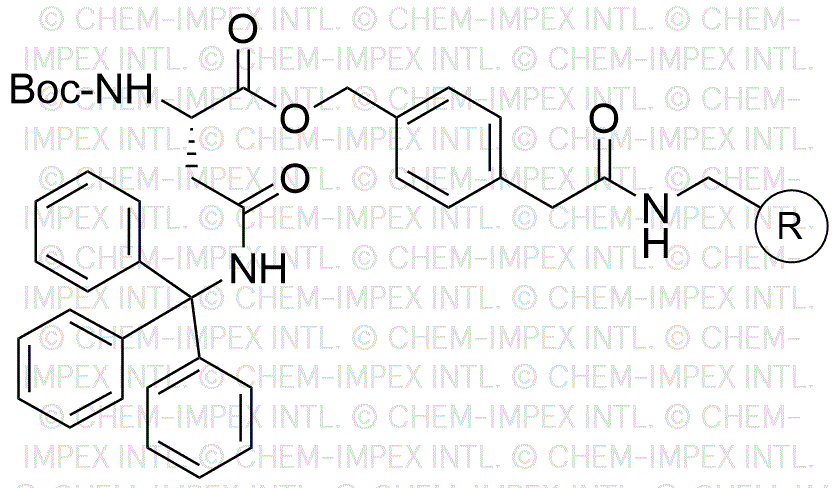Na-Boc-Ng-trityl-L-asparagine 4-oxymethylphenylacetamidomethyl resin is widely utilized in research focused on:
- Peptide Synthesis: This resin is commonly used in solid-phase peptide synthesis, allowing researchers to efficiently create complex peptides with high purity and yield.
- Bioconjugation: It serves as a valuable tool for attaching biomolecules to surfaces or other molecules, enhancing the development of targeted drug delivery systems.
- Protein Engineering: The resin facilitates the modification of proteins, enabling scientists to study structure-function relationships and develop novel protein-based therapeutics.
- Analytical Chemistry: It aids in the purification and analysis of peptides and proteins, providing a reliable method for obtaining high-quality samples for further study.
- Drug Development: This compound plays a role in the design of new pharmaceuticals, particularly in the creation of peptide-based drugs that can target specific diseases.
Información general
Propiedades
Seguridad y normativas
Aplicaciones
Na-Boc-Ng-trityl-L-asparagine 4-oxymethylphenylacetamidomethyl resin is widely utilized in research focused on:
- Peptide Synthesis: This resin is commonly used in solid-phase peptide synthesis, allowing researchers to efficiently create complex peptides with high purity and yield.
- Bioconjugation: It serves as a valuable tool for attaching biomolecules to surfaces or other molecules, enhancing the development of targeted drug delivery systems.
- Protein Engineering: The resin facilitates the modification of proteins, enabling scientists to study structure-function relationships and develop novel protein-based therapeutics.
- Analytical Chemistry: It aids in the purification and analysis of peptides and proteins, providing a reliable method for obtaining high-quality samples for further study.
- Drug Development: This compound plays a role in the design of new pharmaceuticals, particularly in the creation of peptide-based drugs that can target specific diseases.
Documentos
Hojas de datos de seguridad (HDS)
La SDS proporciona información de seguridad completa sobre la manipulación, el almacenamiento y la eliminación del producto.
Especificación del producto (PS)
La PS proporciona un desglose completo de las propiedades del producto, incluida la composición química, el estado físico, la pureza y los requisitos de almacenamiento. También detalla los rangos de calidad aceptables y las aplicaciones previstas del producto.
Certificados de análisis (COA)
Busque certificados de análisis (COA) ingresando el número de lote del producto. Los números de lote y de partida se pueden encontrar en la etiqueta de un producto después de las palabras "Lote" o "Lote".
Número de catálogo
Número de lote/lote
Certificados de origen (COO)
Este certificado de origen confirma el país en el que se fabricó el producto y también detalla los materiales y componentes utilizados en él y si se deriva de fuentes naturales, sintéticas u otras fuentes específicas. Este certificado puede ser necesario para cumplir con las normativas aduaneras, comerciales y regulatorias.
Número de catálogo
Número de lote/lote
Hojas de datos de seguridad (HDS)
La SDS proporciona información de seguridad completa sobre la manipulación, el almacenamiento y la eliminación del producto.
DownloadEspecificación del producto (PS)
La PS proporciona un desglose completo de las propiedades del producto, incluida la composición química, el estado físico, la pureza y los requisitos de almacenamiento. También detalla los rangos de calidad aceptables y las aplicaciones previstas del producto.
DownloadCertificados de análisis (COA)
Busque certificados de análisis (COA) ingresando el número de lote del producto. Los números de lote y de partida se pueden encontrar en la etiqueta de un producto después de las palabras "Lote" o "Lote".
Número de catálogo
Número de lote/lote
Certificados de origen (COO)
Este certificado de origen confirma el país en el que se fabricó el producto y también detalla los materiales y componentes utilizados en él y si se deriva de fuentes naturales, sintéticas u otras fuentes específicas. Este certificado puede ser necesario para cumplir con las normativas aduaneras, comerciales y regulatorias.


